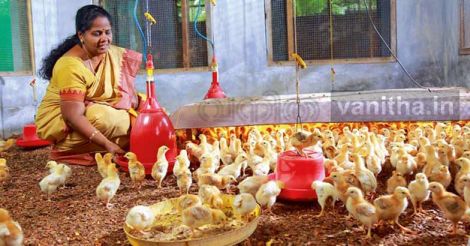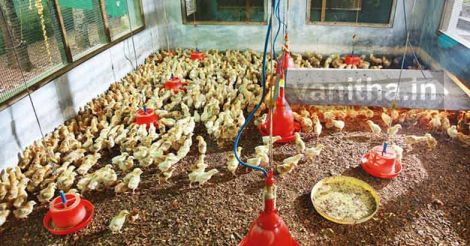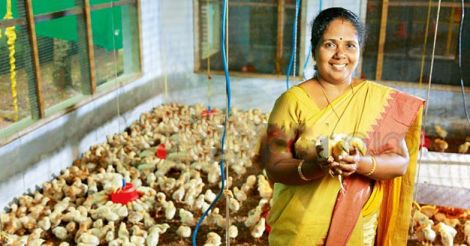Frightened out of your wits by business losses? And shy to venture out again? Say bye to your fears and take a lesson or two from Bindu’s poultry farm in Umayanellore in Kollam.
Walk in to be greeted by four large sheds which house 2,000 poultry birds. That’s her family’s main source of income. Flush with the success of her enterprise, Bindu opens up on how the business has sustained her for the past 12 years.
Her initial plan was to raise quails. But then the concept of quails as a source of food and their eggs as a source of protein was yet to dawn on Keralites. So she chalked out a plan to take eggs from the hatchery in Ellunthara and build up a profitable market in quails. But then all her plans went awry when people shied away from buying quails’ eggs. Nobody was ready to buy the concept of the medicinal value of the bird and its eggs. This apart, there was a smear campaign saying the tiny eggs were in fact snakes’ eggs. This was a huge setback to Bindu, a totally unexpected one. Not even a single egg got sold. This pained her a lot, recalls Bindu.

In fact, her son Subin was more fond of raising hens. It was he who gave his mother the idea of raising poultry, especially chicken, when her business in quails failed. The concept clicked with her too and the first thought was to raise hens for eggs. However, when she went to the hatchery, she realized that the process was not very easy. The hatchery would give her only chicken and she would have to raise them. Besides, she needed a valid certificate to prove her credentials and capability of raising so many birds.
“Thus, my son and I attended a training program. We took up the business only after getting our certificates,” says Bindu.
Though she had faith in her capabilities to handle poultry farming, the true difficulties of raising them scientifically dawned on her only after she underwent the training. The initial business involved bringing home hatched birds, raising them for 45 days and then selling them. This involved minute attention to detail and a great deal of care. On the fifth day you need to administer medicinal drops to their eyes and nose and the vaccine IVD on the 14th day. On the 30th day it’s medicines to de-worm them and finally on the 45th day, an injection. Bindu remembers how scared she was to administer the injections. The birds would invariably slip out of her hands and cause a flutter. But then her determination got the better of her diffidence and soon she mastered her trade. When Bindu started her business, birds were available only in hatcheries. But now things have changed and people come to her to make their buy. The government has fixed Rs 100 for a bird and Bindu sticks to that rate religiously. Today, she sells up to 2000 birds month.
Her life took a turn when her husband, Sudhakaran, decided to call it a day in the Gulf. It was when the family decided to return to the idea of a poultry farm. Since Sudhakaran too is genuinely fond of farming, he too chips in and is of immense support to his wife. Right now, their grown up son who is working in the Gulf is also toying with the idea of coming back and joining the family business.
After all, raising poultry is no big deal, says Bindu. It’s just that someone has to be around the farm every day, at all times.
There are three varieties of of birds here, Kairali, BV380 and Saso. Of these, the BV380 and Kairali are raised together in the same shed. The Saso is sourced from Angamaly. These birds are more expensive and larger in size than the others. But since they are pretty poor at mixing with other breeds, they are raised separately.
Brooder box
Since the chickens are babies in reality, they need the comfort and warmth of their mother hens. But as this is out of question, the right warmth and comfort are provided by 'brooders.' The brooder box is a type of heated enclosure where baby poultry is raised. It has the right temperature with heat lamps inside and provision to hold food and water. Each cover has a dimension of 10 sq ft. An aluminium covering inside the box holds bulbs at the bottom and it’s from this that the chicks get the warmth they need.

The brooder box is scientifically built in that when one bulb inside is turned on, it is meant to provide one watt of heat to one bird. When the lights inside the brooder are lit up, the aluminium covering warms up. The wood shavings on the floor help retain the heat inside. Hence, the chicks crowd round the brooder only when they need to be warm. The automatic drinker system ensures that there’s a steady flow of water into the brooder. The birds are fed inside as any exposure to the world outside may wreak havoc with their fragile immune system.
Points to remember
See that medicines are given at the right time and in the right measure.
If you notice the slightest hint of an ailment in any one bird, take it out immediately and treat it separately.
Great care should be taken to keep the shed clean.
As they are so fragile, the slightest change in weather could cause them to fall ill.
Look out for signs of unease and treat them.
Read: Women Business News | How a young woman gives wings to your music dreams online

























